the tom quest seriesTitles List - Facebook Fan Forum Home by Fran Striker Author of the famous Lone Ranger series. 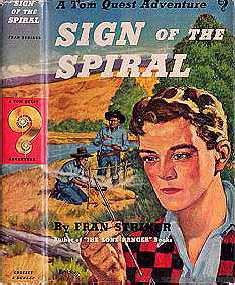 In the Tom Quest adventure series, by Fran Striker, we find none of the defects that somewhat marred his earlier Lone Ranger stories. The Tom Quest books are free from most of the restrictions on action and location that limited the western heroes, and at the same time they benefit from the author's now practiced writing ability, which was considerable to begin with. As a result, the Tom Quest stories contain terrific force to evoke excitement and adventure through strange, mysterious settings. In the Tom Quest adventure series, by Fran Striker, we find none of the defects that somewhat marred his earlier Lone Ranger stories. The Tom Quest books are free from most of the restrictions on action and location that limited the western heroes, and at the same time they benefit from the author's now practiced writing ability, which was considerable to begin with. As a result, the Tom Quest stories contain terrific force to evoke excitement and adventure through strange, mysterious settings.The characters in this series act against a wild backdrop that includes such items as lost cities, jungles, poisoned darts, brooding cypress trees and swamps, headhunters, deserted ships on the high seas, mysterious tunnels, hieroglyphic writings on stone, ghost towns, vanished civilizations and artifacts, gold, uranium, chloroform, secret eyes watching with malice behind blank windows, and more, plenty more, all pervaded by humor, mystery, and wonder. Furthermore, the actions of these characters build upon each other, from book to book, so that, rather than being forgotten once a book is over, they add to the current mood and are referred to, which links the stories irto a consistent, unified whole, a true SERIES rather than just a group of books about the same principal character. But who is this principal character? Right here we notice the main oddity of these books. While the Hardy Boys books are about the Hardy Boys, the Ken Holt books about Ken Holt and so on, the Tom Quest stories feature a guy named Gulliver. (No other name; that's it, just Gulliver.) Oh, sure, Tom Quest is in there, but he has to take a back seat to Gulliver, often literally, as the gigantic, weather-beaten lug drives his battered jeep at breakneck speeds with no windshield or muffler through unknown and roadless wilderness. Accompanied always by his ancient wooden medicine chest, a relic from the times of antique sailing ships, Gulliver comes equipped to face a variety of strange emergencies. The old chest he hauls around with him contains all sorts of interesting stuff, from dynamite to hot sauce, and its original medicine remedies for every conceivable ailment, but numbered (not labeled) to the order of a vanished book of directions. Gulliver remains in doubt about the uses of some phials and jars, but trial and error is his method, and he is prone to act sometimes with great directness to find out whichis which. In the case of the dangerously similar pair, Numbers 17 and 71, one phial contains a soothing ointment; the other a sinister and caustic, blistering decoction that can be used for chemical branding of cattle, so corrosive it practically eats a hole through its own jar. When Gulliver decides to test some phial to see whether it may be appropriate to use for a current emergency, those around him shudder as he wonders aloud whether this or that is castor oil or nitro solvent... But his ludicrous blunders have an odd way of turning out for the best, or, when not advancing the story line at all, providing true comic relief that has often made me laugh out loud. 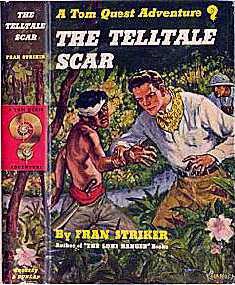 "I got blame near everythin' in here," he said proudly. He studied the jars. "One of these has some stuff in it that's good for sunburn an' insect stings. It’d likely ease off that face." "Whiz felt of his sunburned face. It hurt. "Salve would help,' he admitted. Gulliver held two jars. "Only trouble is," he muttered, 'I forgit if it's one-seven or seven-one. I know one of these is good for what you got." "What's the other?" "It's stuff I use on steers. Yo' put it on with a stick an' it eats right into the hide. It's achemical brand an' a lot easier to use than a brandin’ iron." "My face doesn't bother me a bit," Whiz said quickly. "It feels fine." Gulliver had the lid off one jar. "I can try a little smidge on yo' chin and see if it starts smokin’," he suggested. "No!" shouted Whiz emphatically. Besides Gulliver and Tom Quest, the other principals in this series are the somewhat cynical newspaper columnist Whiz Walton, and Tom's father, Hamilton Quest, a reserved and almost shadowy figure whose attachment to science aiid mathematics motivates action in several of the stories, even when the older Quest is absent. At the start of the series we learn that while on a scientific expedition with Mr. Quest years before, Tom's mother died of tropic fever in the jungles of Peru, and subsequently Hamilton Quest himself disappeared there, never to be heard from again until an expedition in book two of this series finds him and brings him back to civilization. His son Tom, during all this time, has grown up under the care of Mr. Quest's old friend Gulliver, a giant, rough-hewn granite block of a man with a voice usually described as sounding like a buzz-saw rasping on a sheet of rusty tin. Gulliver is a man with absolutely no tolerance for the idiotic and insincere refinements of polite society. One of his most endearing qualities, to me at least, is his lucid and entirely natural hatred of one-way streets. Gulliver was an awe-inspiring individual. Even without his highheeled boots he stood well over six and a half feet and weighed close to three hundred pounds- none of it fat. His head seemed to rise from his massive shoulders with no neck in between, and his chest had the proportions of a barrel. His eyes were deep-set beneath thick eyebrows that met above his broken nose to form a solid hedge of bristling black at the base of a sloping forehead. In Texas, where he had been born and brought up, Gulliver had often wrestled with angry steers and wild horses. His face bore scars from these engagements and from rodeo constest. And there were scars from later battles against wild beasts and jungle savages in remote parts of the world... Gulliver was unwaveringly loyal and the possessor of tremendous strength and raw courage. But equally important was the wisdom he had acquired by years of existence close to Nature. His knowledge came from all things living as distinguished from knowledge acquired from books and colleges. Forests, mountains, and plains had been his classroom, and all out-of-doors his study, where beneath the stars he meditated on his observations. Early in the initial volume, "Sign of the Spiral", Tom Quest meets Whiz Walton, the fast-talking journalist who has grown weary of life among the savages of the money-hungry metropolis: 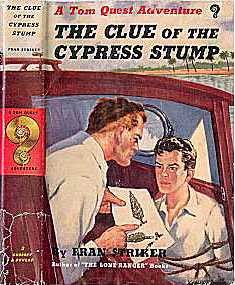 Back home in New York, Walton was a well-known individual. Fifteen years as a columnist had won him a wide and varied list of friends... Held seen so much of life that his own emotions were dulled andhehad become cynical and tolerant. Whiz Walton's existence hadbeen an endless round of irregular hours and a diet consisting mainly of rich night-club food, indigestion tablets, headache remedies and cigarettes. His nerves were ragged from the constant pressure of a deadline, and from sleeping with one ear cocked to catch the jangling of a telephone that might start him on an exclusive story... And finally, Tom Quest is described this way: Modesty concealed many of Tom Quest's attributes. His mother's warm, sympathetic nature and handsome features were obviously his by inheritance, but one had to know Tom well to realize that he had also inherited his father's brilliant mind. Hamilton Quest, once a college professor, had written a number of scholarly books on subjects that included applied logic, psychology, and the higher branches of mathematics. Tom, despite his youth, had read and studied these, and had frequently applied this specialized knowledge to solve problems that stumped Gulliver and Whiz Walton. In "Sign of the Spiral", Tom, Whiz and Gulliver set out to learn, if they can, whether Toni's father is still alive. Gulliver wants to find John Hanford, Quest's engineer colleague who had also vanished in the Peruvian jungle ten years previously, but who has now returned to the United States. A photograph that Gulliver has seen in a newspaper shows Hanford while still in the jungle, flanked by savages, one of whom is wearing as a decoration a spiral-shaped brooch that had once belonged to Tom's mother. Gulliver and Tom believe that Hanford may possess information about whether Hamilton Quest is still alive. Hanford proves difficult to find, however, and the search for him leads the trio to a mysterious hotel in the deserted and lonely ghost town of Horsehead. Hanford, now a prisoner of criminals there whom he had at first assisted, had been lured to the isolated spot to solve an engineering problem. By the end of the book Tom, Whiz and Gulliver have learned that Tom's father is a captive of the Jivaro Indians of Peru. With this knowledge and their rewards for providing the information that resulted in the arrest of the ghost town headquartered Ace Carmody gang, the three conclude the first book with plans to mount an expedition into the jungles of South America. 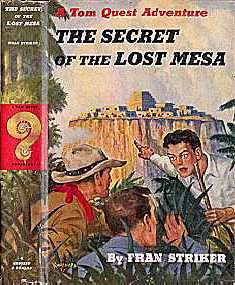 By this point the Tom Quest characaters are already quite well developed and distinct. Whiz Walton, who begins the series jaded and mistrusting, reaches a new understanding of the world through his acquaintance with Tom, Gulliver,and their friends. He looked to the east. The horizon was faintly outlined against the first pale streaks of dawn. A slight breeze, delicately scented after sweeping countless miles of fragrant grasses, brushed his face. He took a deep breath. The clean air touched the very bottom of his lungs. It was heady and exhilarating. It seemed to dust the red imps of suspicion from his brain. His thoughts became aligned in a new pattern. And then he under stood.He understood a lot of things. He realized that he was away from scheming to be paid for everything you do and bargaining for everything you get. He was away from the civilization that demands a cash tip for every favor... Whiz, Tom, and Gulliver rescue Hamilton Quest from his long captivity among the Jivaros in the following book, "The Telltale Scar". The primitive savages, convinced that the scientist's simple sleight-of-hand tricks and knowledge of medicine make him a powerful witch-doctor, have guarded Quest and revered him as "Jatun-Jatun Curaca" - The Great-Great Chief. Gulliver dazzles the Indians with a monster light show of fireworks and other bewildering effects, one of which blinds the tribesmen long enough for the expedition, and Hamilton Quest, to slip away. During these first two books, which really are like one long book, we have seen Gulliver's amazing medicine chest emerge several times, both as a storehouse of essential implements and as a prop for Gulliver's incredibly hot food preparation, which takes on a legendary aspect as the series progresses. In addition to the chest's original contents there were herbs and spices that Gulliver favored in his cooking, and an assortment of other items including saddle soap, machine oil, cartridges, spare parts for the jeep, friction tape, sewing needles, thread, buttons, keys that had no earthly use, nails, screws, nuts and bolts. Gulliver was dead set against throwing anything away. The "herbs and spices" that Gulliver favors are searing blends of white-hot chili powders and scorching sauces that no normal palate can tolerate at all, but which Gulliver enjoys and sloshes onto his food in gargantuan quantities. Meals prepared without these mouth-blistering powders and condiments, to Gulliver's way of thinking, lack authority and are "pulin'" - a word he uses constantly to mean weak, bland, or tasteless.  Gulliver heaped his dish with beans from one of the lard tins. Tom loaded his plate from the other. Whiz looked into both tins. Both held beans and looked identical. "What's the difference?" he asked. "Tom can’t eat seasoning Gulliver explained briefly. Whiz generally used condiments. He liked horseradish and sauces, and wondered why Tom was so finicky. "What's the matter?" he asked. "Is Tom allergic?" Gulliver wasn't sure of the word, but it didn't matter. He couldn't have answered anyway. His mouth was too full. He nodded and let it go at that. The expression of ecstasy on his battered face was enough for Whiz Walton. He loaded his plate with the frijoles Gulliver had spiced. 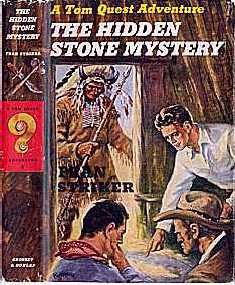 "I’m starved," he said, forking up a mouthful. It was like white-hot lava. The reporter felt his tonsils shrivel fromthe touch of something searing; from lips to esophagus he felt like a blast furnace; tears sprang into his eyes and rolled down his sunburned cheeks. It was as if someone had filled his mouth with molten metal. He thought of the chemical that was used in place of a branding iron and wondered if, by some mishap, held gotten a concentrated dose of the stuff... In "The Hidden Stone Mystery", a truck driver hears Gulliver bragging about food that has "authority", and arranges for a sample: Lou Gates said, "I’ll see if you’re as good as Smoky Joe." He put a massive chunk of meat into his mouth and started chewing. Then he stopped. He stopped with his mouth half open. His eyes opened wide and fairly spurted tears. His plate moved slowly to the ground as if by its own weight. Gates had the lifeless, stupefied appearance that might come with the impact of a bolt of lightning. Then he regained control of his voice and muscles, and as if in sheer exuberance at the sudden release from total paralysis, every muscle moved at once. His head jerked back, he leaped to his feet, and his hands shot out before him like those of one who has been stricken blind and gropes in darkness. The shrill cry of utter agony that split the night must have wakened every sleeping creature for miles around. The woods resounded with the frightened cries of birds, and a rustling of dry leaves on all sides gave evidence of countless small animals escapingfromaworld ofterror. Gulliver lowered his empty plate and offered a canteen to Gates. "I," he said placidly, "keep water handy in case there happens to be a sissy that don't like food with authority." This love for food that has Authority provides a running source of comedy in these books. In #3, "The Clue of the Cypress Stump", while deep in the Everglades, to keep from offending his host, Chief Osceola of the Seminole Indians, Gulliver is forced to eat a bowl of sofkee, a tasteless goo made of cornmeal mush: Gulliver glowered... then threw back his head and held the bowlover his wide-open mouth. The mass of glutinous stuff dropped into the cavernous opening with a soft glop. Gulliver gulped it down with two prodigious swallows. He shuddered. Osceola said, "You like sofkee?" Gulliver forced his face into a pleased expression and spoke in a tone that gave the chief an entirely mistaken idea of the meaning of the words. "Never in all my born days did I eat anthin' more pulin’." He went on quickly, before the happy Indian could suggest a refill... This particular meal is topped off by wild oranges, sour beyond measure, that "could be compared to a combination of styptic pencil and sulphuric acid." The oranges, at any rate, appeal to Gulliver. He finishes one, and as he reaches for another he says, "these here things got authority." Book #4, "The Secret of the Lost Mesa", begins as Whiz, Tom, and Gulliver travel on vacation through Mexico. In Tampico they find a camera floating on the water, attached to a small parachute. Inside is film, which, when developed, shows aerial views of a strange mesa, a high table of land in a lost valley, with an unknown city of what proves to be ancient Aztecs on the top. 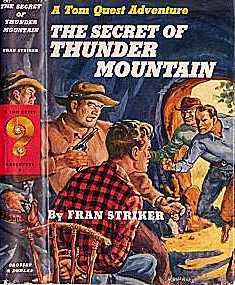 The three set out in Gulliver's beloved indestructible jeep to find the place. Unfortunately, an escaped killer and ex-Nazi from book three, named Koerner, has learned of the mesa too, and has already reached it. The Aztecs there regard him as a god, which adulation Koerner hopes to use in his sinister plot to seize control of Mexico. Tom and his friends are captured, and Tom is scheduled to be executed by being fed to the Aztecs' god, Texcatlipoca, who is in the form of a hideous albino crocodile. Tom escapes death by using a lens from his binoculars to focus the sun and burn the ropes tying him, and sets Whiz and Gulliver free. Gulliver finds his jeep, shifts into four-wheel drive, roarsupthe stairs of an ancient temple, and batters down a chamber's locked doors to apprehend Koerner. This jeep is very dear to Gulliver, and he treats it with every evidence of great affection except cautiousness in handling. He drives it not only up this stairway, but through other axle-busting landscapes, boulder-strewn and ruttedby gullies, up the near-vertical sides of a mountain, and so on. The jeep has no paranormal capacities, but it is to ordinary cars as Gulliver is to ordinary people: battered, exaggerated, tenacious and impudent, but not without limits. The bond between Gulliver and his car is so strong that interference by someonewith his jeep at one point brings Gulliver out of a virtual coma. When at the Lost Mesa the big man is knocked out by a drug in his food, his friends are completely unable to awaken him. But as the criminal Koerner starts Gulliver's jeep a short distance from the room where the friends are imprisoned, and the little car's uninuffled motor roars, Gulliver stirs from his drugged stupor and awakens raging at the effrontery of anyone who would so much as touch his jeep. The jeep gets a couple of tune-ups and an oil change in the course of the series, during lulls in the action, but no other repairs or maintenance,which,considering the rough treatment the thing receives and the odd tasks it is called upon to perform, is really remarkable. I should be so lucky with my car. Hamilton Quest is accused of fraud in book #5, "The Hidden Stone Mystery". After Quest deciphers the writing on an old stone marker showing that land a mining company has been developing in a search for uranium actually belongs to the Mandan Indians, the mining syndicate substitutes a false marker and charges collusion between Quest and the Indians to defraud the company of its claim. "The Secret of Thunder Mountain" (#6), utilizes Gulliver's Texas ranch as a setting- a ranch that Gulliver seems to spend precious little time on. Here a cavern in a nearby peak is being utilized by ruthless killers who robbed an armored car of three million dollars in gold several years before. At Thunder Mountain the gang have high-powered electric furnaces to melt the gold and local rocks together to form an appearance of ore which they then hope to be able to "legitimately" reprocess without suspicion. But their huge electrical generators and furnaces produce a loud static interference on television and high-frequency radio bands, and in an effort to track down the location of this static in order to help out a friendly old man whose television reception is being ruined, Tom builds a radio direction-finder which is, incidentally, described with complete technical accuracy. (In fact, as a boy, I once built a similar one after reading this book.) Plotting on a map from two different locations the directional readings for the static, Tom finds that the two lines on his map meet at Thunder Mountain. 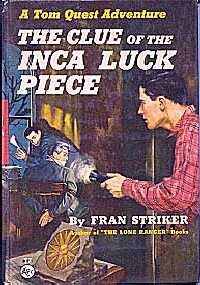 This book contains some of Fran Striker's very best writing, from the descriptions of Hamilton Quest's somber victorian apartment in New York City to the killer waiting in the weeds of a vacant lot in Texas, sweating in the hot sun and slapping at a bug on his hand. The tone, detail, and pace of this book are unsurpassed. From the evidence of an old dust-jacket blurb, this title apparently was intended differently at the beginning. The blurb says: Was the mine on Thunder Mountain haunted? Tom Quest had to go through an amazing adventure before he found out. Fran Striker must have changed his mind a bit later, since in the actual story there is no mine whatsoever on. the mountain, nor any speculation about anything being "haunted". An icy breath of the Cold War blows through "The Inca Luck Piece", number 7 in the Tom Quest series. While Whiz Walton and the editor of the paper he works for, The Metropolitan Journal, discuss Hamilton Quest's latest plans to determine the origin of an ancient Inca medallion of gold and radioactive stone (actually uranium ore), a man listens outside the door. His eavesdropping starts "the operation of a smoothly functioning "unit of Communist spies." To my knowledge this is the only boys' series book of the 1950s to actually come right out and name Communists as the enemy, though others, like Rick Brant, dropped broad hints. ‘The Inca Luck Piece' (or, as it is sometimes titled in an alternate printing, "The Clue of the Inca Luck Piece") is a true whodunit, taking place at the fancy island home of a millionaire. Various characters are introduced- a worthless rich playboy, a writer trying to get backing for her latest play, the millionaire, even a butler. The millionaire's old Inca relic must be photographed in detail; the hieroglyphic writing on it has to be deciphered and the location of its origin determined. For there, presumably, is to be found a rich source of uranium ore. The lurkingredsaredetermined to get hold of Quest's findings as soon as he reaches a conclusion inhis studies of the stone. Although this book represents a departure from the type of story found in the books before it, it is well written and could even be reprinted today without seeming too dated, Commie element and all. So, for that matter, could the entire series. "The Inca Luck Piece" is the last fully original Fran Striker book. Which brings us to the final story, "The Mystery of the Timber Giant", number eight. Like the final Grosset & Dunlap Lone Ranger book by Striker, this is a re-written version of one of his earlier stories about another character (Gene Autry), but is a far better story than the re-write that closes the Lone Ranger. Here, original Tom Quest material is written for the opening of the book, up to about page 40, where it begins to be very similar to- and after page 50 almost identical to- Striker's 1946 book, "Gene Autry and the Redwood Pirates", in which a syndicate seeks to gain a monopoly of the lumber market by threatening, swindling, or burning out independent land-owners. The tale is well enough done, but it lacks a lot of the charm of the rest of the series, even though Striker has taken pains to write into it passages about Gulliver's medicine chest, the jeep, etc. 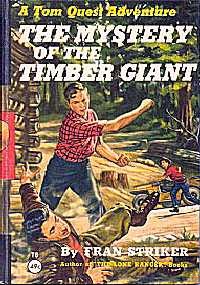 And so Tom Quest ended after only eight books. My guess is that the series was more or less an experiment by Grosset & Dunlap to see how well a series featuring science-adventure would do, and the publisher eventually decided to cancel Tom Quest in favor of continuing Rick Brant, which began as somewhat the same kind of thing. Both series included a boy whose father was a famous scientist; both traveled to exotic locations and discovered lost cities, built home-made electronic devices, and so forth. But Tom Quest's sales must have been slow in comparison to Rick Brant' s, as evidenced by the fact that it is much harder to find Tom Quest today than itis to locate early Rick Brant books from the same years. In 1957 cheap reprints by Clover Books of the Tom Quest series were sold in variety stores across the country. There were at least two editions of all of these, judging from the two spine variations; all had glossy printed covers reproducing the pictures from the old dust-jackets, and they were not unattractive. But the binding and paper were not nearly as high a quality as the former G&D editions, and they're usually in poor shape today. For some reason, it's extremely hard to find Clover's reprints of volume #1, “Sign of the Spiral", although the Grosset edition is still to be seen occasionally, while the later Grossets are just as scarce as the first Clovers. (G&D probably did not ever issue numbers 7 and 8 at all.) So a set consisting of all the same kind of editions is pretty hard to get together. It is really rather sad that these books have fallen into such oblivion, because Tom Quest was one of the finest, most polished and exciting mystery and adventure series that has ever been written, and it certainly included the very best of Fran Striker's writing. It's ironic that it is hardly remembered in connection with his name at all. For subscription & other information, write The Review PO Box 3488 Tucson AZ 85722 Publishing HistoryGrosset & DunlapFrom 1947 through at least 1952, Grosset & Dunlap published the first six volumes of the series. The books had full color dustjackets and were bound in a dark red composition binding with black lettering and a small spiral insignia in red and black on the front cover and red lettering on black background on the spine. Volumes 5 and 6 of the G&D editions are difficult to locate. Clover Books (McLoughlin Bros.)
|